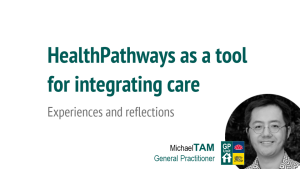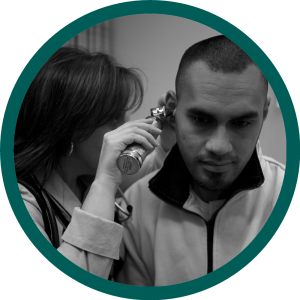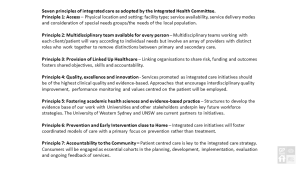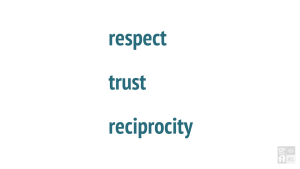 This presentation was given as an oration at the South Western Sydney Local Health District, and South Western Sydney PHN, Integrated Care Forum, held at Liverpool Hospital, on Wednesday 16 September 2015 (Integrated Care Forum Program).
This presentation was given as an oration at the South Western Sydney Local Health District, and South Western Sydney PHN, Integrated Care Forum, held at Liverpool Hospital, on Wednesday 16 September 2015 (Integrated Care Forum Program).
Audio recording:
Audio PlayerTranscript
Hello! Good afternoon.
I’m Michael Tam, a GP at the General Practice Unit in Fairfield Hospital. For those of you who aren’t familiar with the GP Unit, this is an academic family medicine clinic that integrates a clinical service, medical education of students and vocational trainees, primary care research, and liaison between community general practice and hospital services. This is an uncommon model with only two academic GP Units in NSW – Fairfield Hospital and Hornsby Hospital.
I’ve previously worked as an academic in the UNSW Medicine Program, a medical educator in the GP vocational training program, and for about 7 years in private general practice in the Sydney Inner West. I have a few other hats related to mental health.
Presently, I’m one of the GP clinical editors of the SWS implementation of HealthPathways, which was launched earlier this year. However, this isn’t my first experience with HealthPathways.
In this short presentation, I will share some of my reflections about HealthPathways as a tool for care integration, from a number of different disciplinary lenses. I hope that some of these perspectives and insights will help us all frame the path ahead.
 Can I first ask, who here is a GP? Can you raise your hand?
Can I first ask, who here is a GP? Can you raise your hand?
My first lens is from a community general practice perspective. My story begins a little over two years ago. I was sitting in your position, in an auditorium very similar to this one at Royal Prince Alfred Hospital. The Sydney Local Health District and then Inner West Sydney Medicare Local invited the local GPs to attend a function to introduce a new integrated care project. HealthPathways. I was one of the GPs who went. In the audience, I noticed a few familiar faces – the usual suspects as it were – the GPs who tended to go to these things.
The presentations started. I don’t remember exactly the order of the presentations, but it was rather similar to the HealthPathways forum held for South Western Sydney at the beginning of this year. There were some senior members of the LHD and the Medicare Local spoke about the initiative. A team from the Hunter New England LHD spoke – they were clearly passionate about their implementation. A delegation from Canterbury New Zealand, who created HealthPathways, proudly described how it all came about and some of the results that they had seen. The presenters notably didn’t include a grassroots, or coalface GP.
Looking back at that meeting, there was an interesting dynamic in that room. There were many excited people about HealthPathways, but the GPs, me included, were sceptical.
We asked some uncomfortable questions – surely the success with care integration had more to do with the funding structure of the New Zealand health system than necessarily HealthPathways? Have not some of the system redesign been made possible with the crisis caused by the Christchurch earthquakes?
When we were shown some of the Canterbury and Hunter New England pathways, the first thought that everyone had was “why would I want to use this?” In particular, when compared to the existing range of point of care clinical resources of which there are many – e.g., Therapeutic Guidelines series, or Dynamed which we have access to through the College website.
Behind the scepticism, was also suspicion. As a community GP, getting a patient access to public services, for instance, outpatient clinics, has become more difficult rather than less so over time.
Some clinics no longer exist. Some refuse external referrals. Many only accept referrals through a “black box” type mechanism – a referral goes in, but you never quite know when and how the patient will get the appointment. An important context to also realise is that the experience of our GP colleagues in some of the other states is that “pathways” type initiatives are experienced as administrative barriers, rather than care facilitators.
But it wasn’t all bad!
The one thing that seemed to come through was that the HealthPathways process seemed to take GP consultation and perspectives seriously. The documents would be written or localised by local GPs, with intention for use by local GPs. Local hospital clinicians and other content matter experts would provide valuable feedback and discipline specific knowledge, but fundamentally, the documents were not written by them. The collaboration between local GPs and hospital clinicians was hoped to drive system redesign that actually mattered and was a priority to GPs, and the patients they cared for.
 This brings me to my second lens on HealthPathways, and the second part of my story.
This brings me to my second lens on HealthPathways, and the second part of my story.
Does anybody here know Dr Linda Mann? She was awarded GP supervisor of the year by the Royal Australian College of General Practitioners last year – an honour that is very well deserved. Linda took on the role of GP clinical lead for the Sydney HealthPathways, the same role that Dr Chee Khoo performs in our HealthPathways. Anyone who knows Linda would probably agree that she is a very formidable individual and so when she personally invited, or instructed, me to be a GP representative at the Mental Health and Drug Health workshops, I didn’t dare refuse.
The idea behind the HealthPathways workshops is that important clinician stakeholders on a topic from both the community and hospital sectors would meet, discuss, and identify priority areas for pathway development.
So I arrived at the mental health workshop. This was held in a meeting room at the Inner West Sydney Medicare Local premises in Ashfield. The meeting begins with the typical introductions. There are about 3 or 4 GPs, myself included. A few of the local hospital psychiatrists. A clinician from the crisis team. Youth and adolescent mental health, I think, and a few others. The tables were arranged in a U-shape, and obvious to everybody once things got started was that the GPs were all clustered on one arm of the U. Interestingly enough, the recently held mental health workshop for our health district, self-organised to the same seating arrangement – GPs all on one arm of the U – the side closest to exit!
Next, the meeting progresses to discussion on problems and issues. What each member feels is the most pressing clinical issue facing their patients in this domain. I found this next process very interesting. There was a communal airing of grievances. Words were spoken that would, in other contexts, probably be perceived as, insulting is too strong a term, but perhaps blunt and impolitic. And yet, we were making progress!
Clinicians with different professional perspectives, working in different health sectors were seeing the value of each other’s point of view. Seeing together a glimmer of a vision of how they could work better with each other for the sake of their patients, and for the sake of their services, and for themselves.
And to me, this is one of the main if not most important thing to understand about HealthPathways. It isn’t just the product – the online documents. It is the structured relationship building that is fostered between clinicians from different parts of the health sector.
After the agenda items of the workshop finished, the participants didn’t all immediate leave and go home. Many stayed and continued their conversations into the night.
The mechanics underlying integrating care is relationships. Integrated care is only a goal because some individuals may have their health meaningfully improved by having access to more than one health care practitioner. Better that they work synergistically together, than in parallel or independently.
 There have been various ways of thinking about integrated care and the following seven principles have been adopted by our Integrated Care Committee. To me, this is a list of items describing some features, goals and aims.
There have been various ways of thinking about integrated care and the following seven principles have been adopted by our Integrated Care Committee. To me, this is a list of items describing some features, goals and aims.
This list has its purpose, but it is useful to step back and focus back on the relationships. I’m going to put away this list for now so that we can think about values. To see the forest from the trees, as it were.
Simply, what do we need to foster for successful implementation of integrated care projects between general practice and hospital services?
 I see three key elements – the project needs to be respectful of the all parties – clinicians in various sectors, consumers, and their carers. The project needs to promote trust between the parties. The project needs to promote reciprocity between the parties.
I see three key elements – the project needs to be respectful of the all parties – clinicians in various sectors, consumers, and their carers. The project needs to promote trust between the parties. The project needs to promote reciprocity between the parties.
Respect – as I’m sure everybody agrees – is critically important in health practitioner relationships. It starts with the seeking, listening, and hopefully understanding of differing perspectives. The MyAgedCare online referral system, which has recently been in the news, is a classic example of not seeking the perspectives of GPs, the largest group of intended users of the system. It made an already cumbersome process of aged care referrals even more onerous.
Not surprisingly, this erodes trust. Unless we believe that the other practitioners are trustworthy, how can we commit to working together and sharing risks? Trust is built by fostering personal interactions. I find it hard to trust, for instance, a referral mechanism that is simply a fax number, especially without feedback. Was the appointment offered? Did they, “they”, understand the urgency and triaged appropriately? Were they able to contact my patient who often doesn’t answer his phone because he’s hearing impaired?
And lastly, reciprocity. You must offer to take a fair share of the burden. I have often observed a significant asymmetry in this. For instance, a service redesign that improves the efficiency or workload for the hospital service, at the cost of increasing the administrative workload of GPs.
For the last year and a half, I have been working at the General Practice Unit where I have a foot in both worlds. I’m still working as a community GP and at the same time embedded as a part of the LHD. What has become of the Sydney HealthPathways since I’ve left? The GPs I know and respect in the region are positive towards their localised pathways, and their implementation. They are part of a process where they have a voice in how things are and how things could be insofar as the LHD. As a clinical editor of our pathways, I get to see every other localisation as well, and the Sydney Pathways are good – for instance, links to local services and options that I never knew existed when I was a GP in Glebe. I’m fairly active in the General Practice social media scene, and I was pleased to read recently registrars reporting how they found the pathways useful in assisting their patients to access care.
As for our own pathways, a group of GPs in our region have been engaged in dialogue with hospital clinicians as part of the process. These are interactions that would have never otherwise transpired.
It is much too early to know whether our pathways will be the transformative health system seen in Canterbury New Zealand. Nonetheless, my story so far ends with a personal anecdote about using the pathway in real patient care.
A few weeks ago, I needed to refer a patient to the Liverpool diabetes clinic with a somewhat urgent presentation. Having written or edited most of our diabetes pathways, I decided that I needed to give them a go.
It was a rather curious feeling as when I got to the referral details I needed, a fax number, my prejudice got the better of me and I felt compelled to call to check that it was actually correct. It was! And my patient was seen on the day – a minor miracle! Kudos to the Liverpool diabetes care team.
Last words – GPs come to the party and become involved. Look at the HealthPathways – give feedback when you don’t think something is okay. Participate in the workgroups – this is an opportunity to be heard and for your experiences and words to have an influence.
Hospital clinicians – be involved. Look beyond the boundaries of your service and remember the greater health context.
Almost all medical services occur in primary care. Almost all counselling and mental health care is delivered by GPs. If GPs referred even one extra patient per year, your service could be overwhelmed. And ultimately, almost all health care activities are actually performed by individual consumers and their carers – a reminder for us all.
Work with us to improve the whole system. Let us together build better relationships based on respect, trust, and reciprocity.
Thank you.
